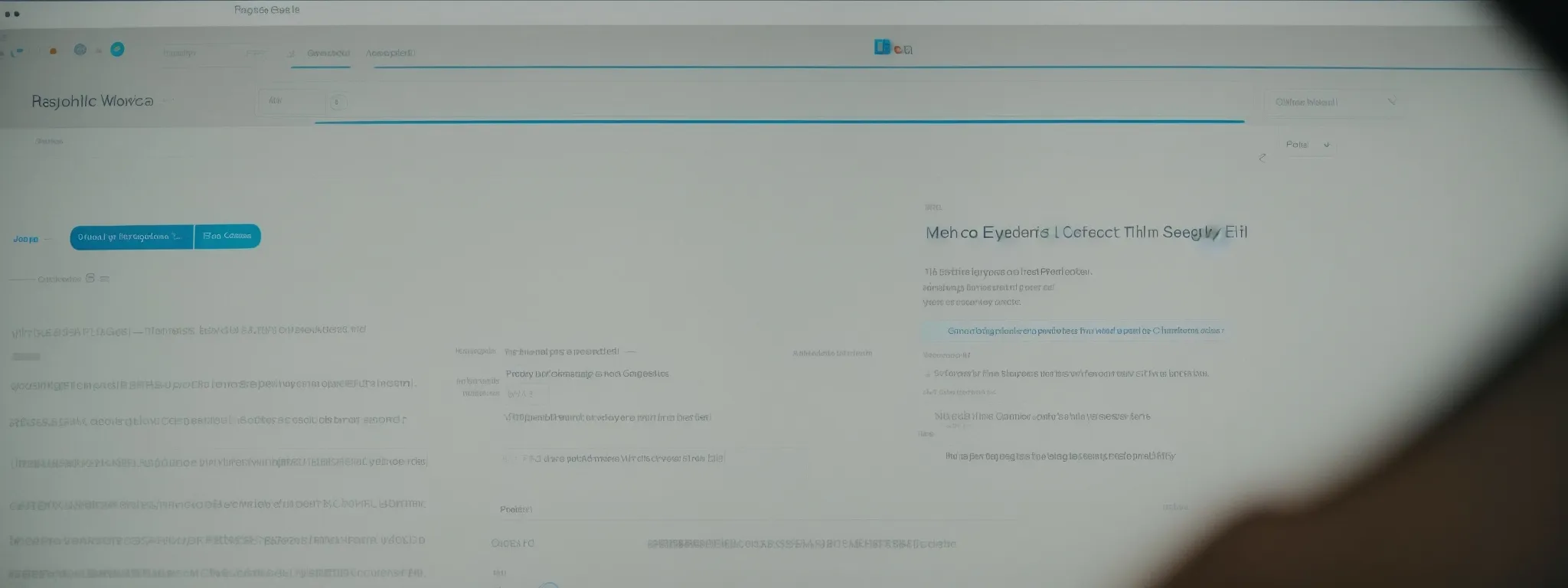SEO Writing for On-Page
Mastering SEO Writing: Essential Techniques for on-Page Optimization Embarking on the journey of SEO writing unveils a landscape where keyword placement, engaging headers, and compelling meta descriptions […]
Mastering SEO Writing: Essential Techniques for on-Page Optimization
Embarking on the journey of SEO writing unveils a landscape where keyword placement, engaging headers, and compelling meta descriptions converge to elevate content in the digital realm.
At the heart of this pivotal undertaking lies a marriage of creativity and analytics, demanding that each sentence serves both the reader’s quest for information and the algorithms’ criteria for relevance.
Effective SEO writing encapsulates the art of embedding keywords with finesse while maintaining a narrative flow that captivates and informs.
In this pursuit, LinkGraph’s SEO services stand as a beacon for those seeking direction and mastery in the ever-evolving field of search engine optimization.
Keep reading to uncover the strategies that ensure your SEO writing not only resonates with your audience but also stands in favor with the almighty search engines.
Key Takeaways
- SEO Writing Balances Keyword Integration and Readability for Both Algorithms and Users
- Proper Keyword Research and Understanding User Intent Are Fundamental in SEO Content Strategies
- LinkGraph’s SEO Services Include Optimizing Meta Descriptions, Internal Linking, and Multimedia Elements for Better Page Rankings
- Continual Learning and Adaptation to Algorithm Updates Are Critical to Maintaining Effective SEO Practices
- Monitoring SEO Performance With Analytics Allows for Data-Driven Strategy Refinements and Improved Search Rankings
Unveiling the Core Principles of SEO Writing

In the domain of digital marketing, content reigns supreme, with its efficacy hinging on the strategic craft of SEO writing.
It is a nuanced art form that intertwines the proficiency of a wordsmith with the analytical acumen of a search engine savant.
Professionals seek to understand the vast influence of SEO on the written word, from the meticulous selection and integration of keywords to the critical evaluation of user intent.
The ultimate goal is to forge content that resonates with both the algorithms that define search engine results and the humans who digest the text.
Grasping the fundamentals of SEO begins with an astute analysis of keyword research, a cornerstone in aligning content with searcher queries, which in turn elevates the user’s journey from query to content consumption.
Understanding SEO and Its Impact on Writing
Mastering the art of SEO writing requires one to recognize the symbiotic relationship between search engines and the stellar content they index. The intentional crafting of text to meet the expectations of algorithms without compromising the reader’s experience necessitates a delicate balance, ensuring that search engine optimization enhances rather than detracts from the reader’s engagement.
One of the pivotal aspects of SEO’s impact is the Heightened Visibility it provides when content is fine-tuned to appease search engines’ myriad criteria. This encompasses not only the strategic placement of target keywords but also the adherence to best practices such as the use of compelling meta descriptions and optimized header tags, which contribute to improved search engine rankings and user accessibility.
Grasping the Fundamentals of Keyword Research
In the arena of search engine optimization, keyword research emerges as a pivotal process, establishing the foundation for targeted content creation. This investigative task entails exploring the search terms that audiences frequently use, discerning not just high-traffic phrases but also the intent and expectations that come with these queries, thus ensuring content aligns with actual user needs.
LinkGraph’s SEO services underscore the importance of choosing the right keywords, drawing on expert tools and insights to construct a robust SEO content strategy. Their suite of solutions, including the SearchAtlas SEO software, aids in unearthing precise keyword data, fostering the development of content that performs effectively in search engine results pages and appeals to the designated demographic.
Analyzing User Intent for Better Content Alignment
Deciphering user intent is a critical element in aligning content with the expectations of an audience, a task that the experts at LinkGraph navigate with precision through their Advanced SEO Services. By analyzing the nuances behind search queries, they enable content to not only reach its intended audience but also to satisfy the underlying needs that propelled the search in the first place.
Integral to the user-centric approach of on-page optimization, LinkGraph’s SEO strategy Meticulously Tailors Content to address the searcher’s journey. It is a sophisticated process that involves mapping out the various stages of user intent, from informational inquiries to purchasing decisions, ensuring that every web page serves a purposeful role in converting a visitor into a customer.
Crafting Compelling SEO-Friendly Titles

The endeavor of encapsulating the quintessence of a well-optimized web page begins with the creation of a title, a striking element that serves as both an anchor and a beacon within the realm of search engine results.
A title that is meticulously crafted, weaving together target keywords with a touch of creative flair, plays a pivotal role in capturing the attention of potential readers.
It acts as a decisive factor in encouraging click-throughs, blending the science of SEO with the allure of engaging headlines to draw visitors into the heart of the content.
Utilizing Target Keywords Effectively
Embedding target keywords into titles demands not only precision but an innate grasp of how these pivotal phrases can enhance visibility in search engine results. LinkGraph’s SEO services prioritize this integration, ensuring that the brand’s essence and the product’s core value proposition are succinctly communicated while maintaining the text’s natural flow and readability.
The harmonious insertion of a target keyword into a title is a nuanced task, one that LinkGraph navigates with expertise, bolstering the mutual relevance between the search query and the resultant web page. This technique sets the stage for the user’s engagement, inviting them to explore the depth of the content that awaits beyond the enticement of a well-optimized page title.
Balancing Creativity With SEO Needs
In the crucible of SEO writing, the melding of imaginative language with strategic keyword inclusion signifies a supreme achievement. An adept SEO content writer must weave a tapestry of compelling narratives that echo with relevance and resonate with the search engine’s design for ranking and relevance. Such a synthesis of imaginative prose and technical optimization begets an outcome where the audience’s curiosity is piqued and search engine criteria are satisfied.
For LinkGraph’s seasoned professionals, striking a balance between creativity and SEO imperatives is not merely a task but an art form, entailing the generation of titles and headers that captivate yet remain dutiful to algorithm-friendly structures. These experts employ a synthesis of SEO principles with an inventive flair, ensuring that each title tag stands as a testament to the brand’s narrative while serving as a magnet for organic traffic.
Encouraging Click-Throughs With Engaging Headlines
Securing the attention of potential visitors amidst the vast sea of search engine results hinges on the magnetic pull of headlines. LinkGraph’s expert team skillfully engineers headlines that are not only enriched with targeted keywords but are also imbued with a creative spark that galvanizes click-throughs, thereby bridging the gap between users’ cursory glances and their commitment to engaging with the content.
It is this deft calibration between the precise demands of search engine algorithms and the natural curiosity of the reader that culminates in higher page visitation rates. By leveraging LinkGraph’s refined SEO services, headlines become potent catalysts for translating fleeting online searches into tangible, sustained interactions with a brand or product’s web page.
Optimizing Meta Descriptions for Maximum Impact

Meta descriptions act as a pivotal interface between the search engine results pages (SERPs) and the user, serving as compelling synopses that can decisively impact click-through rates.
The consummate skill lies not in merely furnishing information but in evoking interest and action through succinct, keyword-infused précis.
In a landscape where brevity joins forces with relevancy, mastering the craft of meta description optimization stands out as an indispensable facet of on-page SEO, catalyzing the journey from search results to website engagement.
Writing Concise, Actionable Meta Descriptions
Adeptly curating meta descriptions demands an economy of words paired with actionable language, driving users to engage with the web page beyond the confines of the SERP. LinkGraph’s SEO services excel in creating such succinct meta descriptions that encapsulate the essence of the content while enticing the reader with a clear call to action, enhancing the likelihood of a click-through.
The expertise of LinkGraph lies in deploying meta descriptions that serve not just as informational snippets, but as strategic tools, cleverly incorporating target keywords to signal relevance to search engines. This precision in crafting meta descriptions ensures they function as an extension of the page title, working in concert to augment the visibility and allure of web pages amidst the competitive digital landscape.
Embedding Primary Keywords Strategically
Strategic placement of primary keywords within meta descriptions is not a mere act of insertion; LinkGraph’s SEO services elevate this practice to an art form. Keywords are woven into meta narratives with precision, ensuring that each phrase acts as a natural, integral part of the message, optimizing the snippet for search engine crawlers and human readers alike.
The skillful embedding of primary keywords necessitates a judicious approach rather than indiscriminate placement. This method is rooted in a deep understanding of SEO best practices and the subtle nuances of language:
- Analyzing keyword relevance to ensure a seamless match with content topics.
- Assessing keyword density to maintain the organic quality of the text.
- Integrating keywords in a manner that prompts user engagement and action.
Through such meticulous optimization, LinkGraph guarantees that meta descriptions become potent vehicles for increasing the visibility of web pages, compelling potential visitors to delve deeper into the website’s content.
Driving Click-Throughs From SERPs
The role of a well-optimized meta description in driving traffic from search engine results pages cannot be overstated; it is the first point of engagement that invites the user to learn more, a critical juncture where LinkGraph’s expertise in SEO sharply increases the likelihood of click-throughs. Their strategic crafting ensures that each meta description is a funnel that captures searcher interest, directly influencing the volume of quality traffic directed to the website.
Success in transitioning a user from SERP to site hinges on LinkGraph’s meticulous approach to SEO writing, which combines relevance and clarity in meta descriptions, thus serving as compelling invitations for searchers. By focusing on clarity of message and alignment with user intent, LinkGraph’s SEO services successfully transform passive interest into active engagement, significantly boosting the probability of a user stepping onto the virtual threshold of a landing page.
Structuring Content for Enhanced Readability

In the pursuit of on-page optimization, content architects must pay close attention to the structure and formatting of their compositions.
Enhanced readability is a central pillar of user experience, fostering an environment where audiences can effortlessly navigate and absorb information.
The skillful use of headings and subheadings, along with the strategic placement of bullet points and the distribution of text into digestible portions, plays a crucial role in this endeavor.
These elements act as signposts and visual breaks, guiding the reader through the narrative pathway laid out by the content creator, and are, therefore, integral to SEO writing excellence.
Utilizing Headings and Subheadings Wisely
Expert leveraging of headings and subheadings is pivotal in SEO writing, as it aids in not only organizing the text but also in emphasizing key points to both search engines and readers. LinkGraph’s seasoned professionals employ headers to create an outline that enhances user navigation, helping audiences pinpoint the exact information they seek, while simultaneously bolstering SEO by highlighting pertinent topics.
Assembling content with a smart hierarchy of headings leads to an improved reading experience, where each header makes a web page’s layout intuitive and exposure to key phrases seamless. LinkGraph utilizes this to construct a roadmap for the reader’s journey through the text:
| SEO Element | Purpose | Impact on User Experience |
|---|---|---|
| Header Tags (H1, H2, H3, etc.) | Organize Content Structurally | Guide Users to Relevant Sections |
| Target Keyword Integration | Enhance Search Engine Visibility | Connect User Query with Content |
| Concise Subheadings | Break Down Complex Information | Simplify Information Absorption |
Employing Bullet Points for Clarity
Clarity emerges as a paramount concern in SEO content writing, and the utilization of bullet points serves as a key tactic in achieving this objective. LinkGraph’s SEO experts harness bullet points to distill complex information into digestible snippets, enabling readers to quickly grasp the core messages and takeaways of a piece, thus optimizing user experience and comprehension.
In a landscape where attention spans are at a premium, bullet points act as beacons of brevity that facilitate rapid information processing. Incorporating bullet points effectively requires a deft touch from skilled content writers such as those at LinkGraph, who ensure that every listed item is impactful, contributing to the overall SEO strategy by maintaining focus and reinforcing the central narrative.
Breaking Text Into Manageable Chunks
LinkGraph’s on-page SEO services impart that the distillation of textual content into manageable sections is vital for retaining reader engagement. Acknowledging that dense paragraphs can be daunting, their approach involves creating shorter content blocks, which enable readers to navigate and comprehend information with ease.
Expert content architects at LinkGraph seamlessly integrate this technique, ensuring that each paragraph encapsulates a singular, focused idea. This practice not only aids in maintaining the reader’s concentration but also benefits the overall SEO efforts by allowing search engines to parse and index content segments with greater accuracy.
Integrating Keywords Seamlessly Into Your Text

In the realm of on-page optimization, the skillful integration of keywords into the body of your content stands as a testament to a writer’s expertise in SEO writing.
The challenge lies in maintaining a careful equilibrium, where the required keyword density does not impede the natural flow and readability of the text – a necessity that underpins the success of any web page.
Content creators must astutely avoid the pitfalls of over-optimization, which risks alienating both the reader and search engine algorithms.
Moreover, the adept use of synonyms and Latent Semantic Indexing (LSI) keywords can further distinguish the text, infusing it with both depth and context to the target audience’s search queries.
Balancing Keyword Density With Natural Flow
Ensuring the organic integration of keywords into content is a nuanced endeavor, where a balance between necessary keyword density and the natural rhythm of prose is critical. LinkGraph’s SEO services navigate this delicate interplay with a precision that enhances the content’s findability without disrupting the reader’s experience.
Overuse of keywords can disrupt the narrative flow and potentially trigger search engine penalties, a consideration always at the forefront of LinkGraph’s SEO strategy. With a focus on the user experience, their content professionals weave keywords into the structure of the text skillfully, maintaining a coherent and reader-friendly composition.
| SEO Element | Function | LinkGraph’s Best Practice |
|---|---|---|
| Keyword Density | Measure Keyword Frequency | Ensure Natural Incorporation |
| Content Readability | Facilitate User Engagement | Maintain Smooth Flow |
| SEO Outcome | Enhance Search Rankings | Achieve Organic Visibility |
Avoiding Over-Optimization Pitfalls
Falling into the trap of over-optimization is a common misstep in SEO writing—an excess that often dilutes the message and detracts from user engagement. Experts at LinkGraph are vigilant, ensuring SEO practices enrich the content’s value, fostering a user-centric approach that prevents the content from becoming an untenable keyword-laden corpus, alienating to both readers and search engine algorithms.
LinkGraph’s SEO services prioritize the subtle art of keyword placement that enhances rather than overshadows the authenticity of the narrative. Their team adeptly navigates the nuances of SEO to preclude any hint of keyword stuffing, thereby upholding the credibility of the web page and safeguarding against the risk of search engine penalties that may hinder visibility and traffic flow.
Synonyms and LSI Keywords Implementation
Incorporating synonyms and Latent Semantic Indexing (LSI) keywords substantiates the depth and contextuality of content, moving beyond mere keyword repetition. LinkGraph’s SEO services astutely embed these variations, enriching the narrative and signaling to search engines the comprehensive relevance of the text.
LinkGraph’s expertise in deploying synonyms and LSI keywords ensures the semantic richness of the content, bolstering its pertinence to an array of related search queries. This strategic expansion of vocabulary nuances the user’s reading experience while simultaneously catering to the sophisticated algorithms of search engines that seek relevance in thematic clusters.
| Element | Role in SEO | Benefit to Content |
|---|---|---|
| Synonyms | Expand Keyword Variability | Enhance Natural Language Use |
| LSI Keywords | Build Thematic Relevance | Broaden Content Reach |
Enhancing User Engagement With Internal Linking

At the heart of on-page optimization lies the adept utilization of internal linking, an SEO technique that not only cultivates user engagement but also fortifies the information architecture of a website.
By mapping out a network of relevant internal links, content creators can guide their audience through a curated journey across their domain, seamlessly connecting related topics and enhancing the overall user experience.
Employing the correct application of descriptive anchor text and strategic linking patterns augments site navigation and promotes content discovery, ultimately reinforcing the site’s structure and the depth of user interaction.
Building a Network of Relevant Internal Links
LinkGraph’s SEO services harness the power of internal linking to enhance navigability and deepen engagement. Through their methodical approach, they build a coherent network of links, enabling a seamless content journey that keeps users engaged and encourages prolonged site interaction.
Efficient internal linking strategies employed by LinkGraph not only assist in distributing page authority across the website, but also lead users toward high-conversion pages. Their expertise ensures that each link is relevant and contextually integrates into the text, driving both user and search engine value.
Using Descriptive Anchor Text
Employing descriptive anchor text is a sophisticated method within on-page SEO to enhance the user’s journey throughout a website. LinkGraph’s SEO services meticulously select anchor text to succinctly convey the content linked, setting precise expectations for the user and increasing the click-through rate with clear, informative cues.
The strategic use of descriptive anchor text not only serves the reader but also allows search engines to discern the context of interlinked content, bolstering the site’s network of information. LinkGraph’s professionals expertly craft anchor text to ensure its relevance and descriptiveness, thereby reinforcing the connection between various contents and improving the website’s SEO architecture.
Improving Site Navigation and Content Discovery
Fortifying Site Architecture for enhanced navigation and the serendipity of content discovery sits at the forefront of LinkGraph’s SEO services. The conscious arrangement of internal links streamlines the user’s exploratory process, allowing for an intuitive traversal through a vast repository of information and fostering a user-friendly environment that both retains and educates the visitor.
LinkGraph’s SEO services intricately design the site’s internal linking structure to act as silent guides towards content relevancy and discovery. This technique elevates the user experience by facilitating seamless access to complementary information, consolidating a visitor’s understanding and appreciation of the subject matter:
| SEO Technique | Function | User Benefit |
|---|---|---|
| Internal Linking | Connect Related Content | Enhanced Navigation |
| Descriptive Anchor Text | Provide Context for Links | Facilitated Content Discovery |
| Link Placement | Strategic Content Association | Intuitive Learning Pathways |
Through strategic link placement and context-driven anchor text, LinkGraph ensures that visitors are not merely passive viewers but active explorers of the site’s landscape. As a result, users are engaged in a journey of discovery, connecting disparate yet related content, that not only satisfies their immediate query but expands their knowledge horizons.
Leveraging Multimedia Elements for Better SEO

Mastering the art of SEO writing transcends the mere assembly of text.
A comprehensive on-page optimization strategy embraces the integration of multimedia elements to augment the user experience and bolster search engine performance.
Professionals understand that optimizing images with purposeful alt text and descriptions, weaving in dynamic videos and infographics, as well as ensuring media loads efficiently, collectively contribute to an enriched content ecosystem.
These elements not only captivate the audience but also cater to the algorithmic preferences of search engines, paving the way for a sensory-rich exploration of information.
Optimizing Images With Alt Text and Descriptions
In the intricate tapestry of on-page SEO, optimizing images goes beyond mere visual appeal. By infusing alt text and descriptions with relevant keywords, LinkGraph’s SEO services ensure that every image contributes to a web page’s search engine ranking, while also providing context for users who rely on screen readers.
Alt text and descriptions are not mere afterthoughts; they are crucial SEO elements that describe an image’s content and function. LinkGraph’s meticulous approach encapsulates this in a seamless digital narrative, improving accessibility for all users and bolstering the site’s keyword strategy:
- Employing descriptive and concise alt text for every image,
- Strategically including target keywords in image descriptions without overstuffing,
- Ensuring alt attributes and descriptions add contextual information enhancing the overall content.
Including Videos and Infographics for Richer Content
Incorporating videos and infographics into content fulfills more than the visual dimension of an SEO strategy; it facilitates complex information being communicated with immediacy and clarity. LinkGraph’s SEO services proficiently integrate these dynamic elements, ensuring that they not only engage but also inform the audience, enriching the content landscape and providing a competitive edge in search engine rankings.
Strategically embedded, these multimedia facets serve to illustrate and reinforce textual content, making abstract concepts tangible and enhancing user understanding. LinkGraph recognizes the power of such visual aids in breaking through informational barriers, improving retention rates, and encouraging social shares, all of which signal to search engines the content’s value and relevance to readers.
Ensuring Fast Loading Times for Media
Fast loading times are an indispensable factor in the retention and satisfaction of website visitors, something LinkGraph’s SEO services are acutely focused on optimizing. Their experts ensure that multimedia elements are compressed and properly formatted to facilitate swift page load speeds, thus maintaining a high level of user engagement and reducing bounce rates, which are crucial components of SEO rankings.
Executing the optimization of multimedia not only improves the responsiveness of a web page but also echoes favorably in the algorithms of search engines. The professionals at LinkGraph are adept in streamlining the integration of imagery, videos, and other interactive content to ensure seamless user experiences that contribute positively to a website’s on-page SEO metrics.
The Importance of Mobile Optimization in SEO Writing

As the digital landscape continues to evolve, the preeminence of mobile optimization in the field of SEO writing becomes increasingly clear.
Professionals in the sphere of on-page optimization acknowledge that the majority of online searches are now performed on mobile devices, compelling a shift in strategies to cater to the nuances of the mobile user experience.
Focusing on creating an adaptable content layout for varied screen sizes, enhancing speed for on-the-go access, and ensuring mobile usability are pivotal steps in optimizing a website for the surging mobile audience.
LinkGraph’s SEO services meticulously refine these factors, ensuring that mobile compatibility is woven seamlessly into the fabric of effective SEO practices.
Adapting Content Layout for Mobile Users
Adapting content layout for mobile users is an imperative in an era where smartphones reign. Content must fluidly conform to smaller screens, ensuring accessibility and legibility without the need for zooming or horizontal scrolling.
LinkGraph’s SEO services specialize in optimizing web pages for mobile consumption by implementing Responsive Design Principles. These practices enable content to automatically adjust to various devices, providing an optimal viewing experience regardless of the device used:
| Design Aspect | Mobile Optimization Technique | User Experience Benefit |
|---|---|---|
| Responsive Layout | Dynamic Content Adjustment | Seamless Transition Across Devices |
| Font and Button Size | Touch-Friendly Interface | Improved Readability and Interaction |
| Loading Speed | Accelerated Mobile Pages (AMP) | Faster Access to Content |
By ensuring content’s fluid adaptability to mobile interfaces, LinkGraph guarantees that the user’s on-the-go experience is as cohesive and engaging as on a desktop. This approach not only retains the mobile user but also enhances the site’s favorability in mobile-first indexing by search engines.
Speed Optimization for Mobile Devices
A critical component of mobile user satisfaction is the swift loading of web pages, which LinkGraph’s SEO services rigorously achieve through advanced techniques. Their professionals employ optimisations like minifying code, leveraging browser caching, and reducing server response times to ensure that mobile users experience minimal wait times when accessing content on the go.
LinkGraph expertly addresses the modern user’s need for speed by incorporating progressive web apps that boost the performance of mobile sites. Understanding that a delay in page response can result in a significant drop in engagement, LinkGraph’s commitment to meticulous mobile speed optimization is paramount in maintaining a competitive edge in today’s mobile-centric online environment.
Prioritizing Mobile Usability
Prioritizing mobile usability within SEO writing is more than a matter of adhering to trends; it is a strategic response to user behavior that increasingly favors mobile browsing. LinkGraph’s SEO services ensure that each element of a website, from navigation menus to form inputs, is optimized for touch control, providing an intuitive user experience that drives engagement and decreases bounce rates.
Mobile usability is intrinsic to the performance of content in search rankings, with search engines like Google using mobile friendliness as a critical ranking factor. LinkGraph’s professionals dedicate their expertise to refining the mobile user experience, delivering content that is not only consumable on-the-go but also poised to achieve superior rankings, solidifying a brand’s presence in the mobile-first digital era.
Staying Updated With Latest SEO Writing Practices

In the ever-shifting landscape of search engine optimization, where algorithm updates dictate the course of digital visibility, professionals in the field recognize the imperative of staying abreast with the latest SEO writing practices.
This ongoing quest involves meticulously monitoring algorithm changes, nimbly adapting strategies to align with evolving SEO trends, and dedicating oneself to unwavering skill enhancement.
For those keen on mastering the art of SEO writing, this trifecta forms the backbone of on-page optimization success, ensuring content not just survives but thrives in the dynamic tableau of search engine rankings.
Monitoring Algorithm Updates
Staying at the vanguard of search engine optimization requires a vigilant eye on the ever-evolving algorithms that dominate the digital sphere. SEO professionals, in their pursuit to retain a high level of proficiency, must consistently track updates released by search engines to refine and recalibrate their strategies accordingly.
LinkGraph’s SEO services embody a commitment to this level of awareness, ensuring that their content strategies are informed by the latest algorithmic shifts and adjustments. By understanding and implementing up-to-date practices, LinkGraph provides clients with the assurance that their SEO efforts are aligned with current standards for search engine ranking success.
- Track search engine announcements for algorithm updates.
- Analyze the impact of updates on current SEO strategies.
- Swiftly adapt content and optimization techniques to align with new requirements.
Adapting to Evolving SEO Trends
In the dynamic arena of SEO, professionals must exhibit agility by embracing evolving trends that shape online content visibility. With each shift, LinkGraph’s SEO services pivot, integrating new methodologies such as voice search optimization and the refinement of AI-generated content to meet the fresh demands of search engines and user preferences alike.
Gravitating toward a holistic approach, LinkGraph’s experts emphasize the importance of rich, comprehensive content that addresses E-A-T (Expertise, Authoritativeness, Trustworthiness) principles, aligning with Google’s ongoing focus on content quality and authority. As these SEO paradigms adjust, the need for content to demonstrate depth, accuracy, and credibility becomes not just beneficial but essential for on-page optimization:
| Trend | Action | Outcome |
|---|---|---|
| Voice Search Optimization | Incorporate Natural Language Processing | Increase Accessibility and Reach |
| E-A-T Focus | Enhance Content Authority | Improve Search Engine Trust |
| AI Content Refinement | Utilize Advanced Tools for Content Creation | Boost Content Quality and Efficiency |
Continuous Learning and Skill Development
In the competitive landscape of SEO, professionals must engage in Continuous Learning to evolve their skill sets and ensure their techniques remain cutting-edge. The commitment to ongoing education is paramount, as it allows SEO experts at LinkGraph to harness the latest insights and tools, delivering client services that resonate with both current algorithms and best practices.
LinkGraph’s devotion to skill advancement positions their team at the forefront of the industry, where expertise in emerging trends converges with the established foundation of SEO principles. Through workshops, webinars, and certification courses, they ensure a culture of perpetual growth, maintaining mastery in the art of SEO writing and on-page optimization.
| Educational Method | Purpose | Benefit to SEO Writing |
|---|---|---|
| Workshops and Seminars | Hands-on Learning Experience | Direct Application of Modern Techniques |
| Webinars | Virtual Skill Development | Accessible Insight into Industry Updates |
| Certification Courses | Acknowledgment of Expertise | Validation of Advanced Capabilities |
Measuring the Success of Your SEO Writing Efforts

Ascendancy in the realm of search engine optimization beckons a perceptive analysis and an agile adaptation to the outcomes of SEO writing initiatives.
Proficient content creators and strategists do not rest on the laurels of published content; instead, they diligently track keyword rankings and traffic to gauge performance.
Examining user behavior and bounce rates imparts critical insights into how effectively content resonates with and retains the target audience.
Considering these metrics as cardinal, it becomes possible to refine SEO strategies based on performance data, thereby sculpting an evermore potent presence in the dynamic expanse of search engine rankings.
Tracking Keyword Rankings and Traffic
Measuring the effectiveness of one’s SEO writing hinges on the diligent monitoring of keyword rankings and the influx of website traffic. LinkGraph’s SEO services provide clients with the tools and expertise to discern the positioning of their chosen search terms within search engine results, an evaluation crucial to understanding the magnetism and draw of their optimized content.
An upsurge in page visits after implementing strategic SEO practices signals the success of content optimization. LinkGraph equips businesses with analytics to assess organic traffic flow, thereby enabling a granular understanding of user trends and interactions:
- Dissect webpage visitor increases to connect with keyword performance.
- Utilize SEO reporting metrics to analyze and refine ongoing strategies.
- Employ data insights to ensure content retains a continuously optimized stance.
Analyzing User Behavior and Bounce Rates
Scrutinizing User Behavior offers an in-depth view of how visitors interact with content, presenting an opportunity to refine SEO strategies. By examining metrics such as session duration and page views per visit, LinkGraph’s SEO services gauge user engagement and the content’s efficacy in meeting audience needs, underpinning efforts to enhance the on-page experience.
Bounce rates stand as a critical indicator of content relevance and user satisfaction; a higher-than-average rate may signal a disconnect between visitor expectations and the content provided. LinkGraph leverages this data to ensure the alignment of content with user intent, thus optimizing the user experience and contributing to improved SEO outcomes.
Refining Strategies Based on Performance Data
In the meticulous world of SEO writing, performance data is the compass by which professionals navigate the ever-changing currents of search engine algorithms. LinkGraph capitalizes on this treasure trove of insights, harnessing analytics to meticulously refine and tailor on-page SEO tactics, thereby cementing content’s prominence in search engine results and user relevance.
Continuous refinement is the hallmark of a robust SEO strategy, and for LinkGraph, it is an imperative practice. They scrutinize interaction patterns and conversion rates to identify areas of improvement, applying Data-Driven Modifications that amplify content’s effectiveness and elevate a brand’s digital footprint.
Conclusion
Mastering SEO writing is crucial for on-page optimization, ensuring content not only appeals to search engines but also provides a compelling user experience.
It involves a strategic balance of keyword integration, readability enhancements, and the use of multimedia elements, all while staying mobile-optimized.
Professionals should continuously adapt to the latest practices, track performance data, and refine their strategies to maintain a strong online presence.
Through expert techniques such as internal linking and meta-description optimization, SEO writing can significantly increase a website’s visibility and user engagement, laying the groundwork for a successful digital marketing strategy.














































































